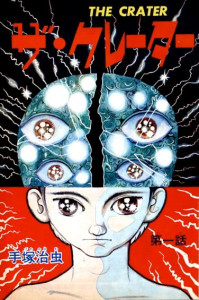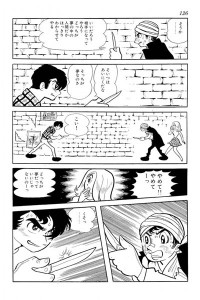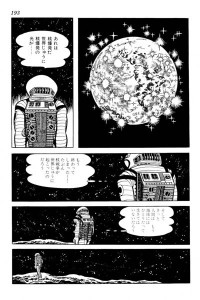Crater, The (Manga)
Also known as ザ・クレーター (Za Kureta)
| English Title: | The Crater |
| In English? | No |
| Japanese Title: | ザ・クレーター Za Kureta |
| Type: | Chapter Serial |
| Original run: | 1969/08/10 – 1970/04/01 |
| Published in: | Weekly Shonen Champion 週刊少年チャンピオン |
| Published by: | Akita Shoten |
| Volumes: | 3 MT-218 | MT-219 | MT-220 |
The series of 17 independent, self-contained short stories that make up The Crater (1969-70) was serialized in Weekly Shonen Champion from August 1969 to April 1970.
What it’s about
Tezuka originally envisioned The Crater (1969-70) as an exploration of the human mind. As he explains as the series opens, since no two human souls are exactly alike, that means there are five billion (and in fact many more) stories that that can be told that focus on the human heart and spirit as their central theme.
In a similar tradition to The Twilight Zone or The Outer Limits, Tezuka treats each story as a morality play – often using combing the characters, the setting and symbolism to impart a message or to make a point. For example, in one instance he might use the ringing bells to denote the pressure of people haunted by their past sins, in another he explores what would happen if a man undecided about what to do with his life was given the opportunity to start it all over again.
While the story genres range from horror, to suspense, to mystery to science-fiction, and the background settings run the gambit from the Second World War, to a contemporary manga studio, they each, in their own way, continue that exploration of the human condition.
What you should know
Although the series is titled The Crater (1969-70), according to Tezuka himself, there is no special significance to the name. In fact, since the name itself doesn’t show up until the very last chapter, it seems likely that this was an attempt by Tezuka to wrap up the series with a sense of unity.
Of course, Tezuka also attempts to create that sense by basically casting Ryuichi Okuno in a starring role in most (though not all) of the chapters. While his character changes from story to story, with a different name and background change each time, at his core he is basically the same good young man – generally honest, though occasionally a bit greedy and lacking foresight. Still, as series go, the linking mechanism is a bit thin. As Tezuka himself suggests in the afterword to the Osamu Tezuka Complete Manga Works edition (MT-220), “the introduction of the boy Okuchin is a laboured attempt to have a sense of unity” (1982, p. 196).
Still, in a similar way to Apollo’s Song (1970), The Crater (1969-70) is a good primer for readers to grasp the deeper, or more “meta” uses of Tezuka’s Star System. Despite the fact that Ryuichi is not really considered one of Tezuka’s major stars, given his many (often tragic) roles in The Crater (1969-70), he does have the dubious distinction of being one of Tezuka’s most long-suffering characters, along with Rock Holmes and Saruta.
With such a wide variety of topics to choose from, many of Tezuka’s favoured themes are explored in The Crater (1969-70). However, perhaps the most frequently occurring of these is that of illusion. This is quite clearly illustrated in ‘Double Drama’, wherein Ryuichi and Jim, two versions of the same person, come to blows to decide which of them is living in the dreams of the other. Of course, the truth is that they both, in fact, may simply be figments of someone else’s imagination entirely.
As is par for the course with Tezuka’s manga, the stories in The Crater (1969-70) are complex and multifaceted. Although they don’t have the depth of a series like Phoenix (1967-88), Buddha (1972-83) or Message to Adolf (1983-85), they can still be enjoyed on many levels. Taken at face value, they can be seen as strange, often humorous or dramatic stories that simply convey a well-packaged lesson in morality. However, upon further inspection, they can also be seen to be thought-provoking explorations of what happens when ordinary people are faced with extraordinary circumstances.
It is also interesting to compare and contrast the themes present in the stories of The Crater (1969-70) with those found in the stories Tezuka wrote for a younger adult audience at roughly the same time and collected as Under the Air (1968-70).
What else you should check out
Check out the link below for chapter summaries and more detailed publication information on the The Crater (1969-70) serialization in Shonen Champion.






